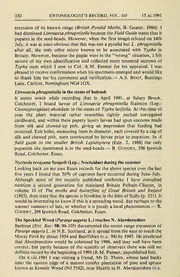
Nycteola revayana Scopoli (Lep.: Noctuidae) during the summer PDF
Preview Nycteola revayana Scopoli (Lep.: Noctuidae) during the summer
330 ENTOMOLOGIST'S RECORD, VOL. 103 15.xi.1991 extension of its known range (British Pyralid Moths, B. Goater, 1986). I had dismissed Limnaeciaphragmitellabecause the Field Guide states that it pupates in the seed-heads. However, when the first imago eclosed on 14th July, it was at once obvious that this was not a pyraHd but L. phragmitella after all, the only other micro known to be associated with Typha in Britain. However, because the pupae were in the "wrong" situation, I felt unsure of my own identification and collected more tenanted sections of Typha stem which I sent to Col. A.M. Emmet for his appraisal. I was pleased to receive confirmation when his specimens emerged and would like — to thank him for his comments and verification. A.S. Boot, Buntings Lane, Carlton, Nottingham NG4 IGX. Limnaeciaphragmitellain the stems ofbulrush It seems worth while recording that in April 1991, at Salary Brook, Colchester, I found larvae of Limnaecia phragmitella Stainton (Lep.: Cosmopterigidae) abundant in the stems of Typha latifolia. At this time of year the plant material rather resembles tightly packed corrugated cardboard, and within these papery layers larvae had spun cocoons made from silk and chewed-up pith, giving an impression that feeding had occurred. Exit holes, measuring 1mm in diameter, each covered by a cap of A silk and chewed pith, were constructed by larvae prior to pupation. In field guide to the smaller British Lepidoptera (Edn. 2, 1988) the only — pupation site mentioned is in the seed-heads. B. Goodey, 298 Ipswich Road, Colchester, Essex. Nycteolarevayana Scopoli (Lep.: Noctuidae) during the summer Looking back on my past Essex records for the above species over the last five years I found that 50% of captures have occurred during June-July. Although none of the recently published textbooks I have consulted mention a second generation for mainland Britain Pelham-Clinton, in volume 10 of The moths and butterflies of Great Britain and Ireland (1983), does state that the species is bivoltine in the Isles ofScilly (p. 321). It would be interesting to know ifthis is a spreading trend, due perhaps to the — warmer summers of late, or whether it is purely a local phenomenon. B. Goodey, 298 Ipswich Road, Colchester, Essex. The Speckled Wood (Parargeaegeria L.) reaches N. Aberdeenshire Barbour (Ent. Rec. 98: 98-105) documented the recent range expansion of Pararge aegeria L. in N.E. Scotland, as it spread from the west to reach the Moray Firth by about 1954 and Banffshire (v.c. 94) by 1983. He predicted that Aberdeenshire would be colonised by 1986, and may well have been correct, but partly because of the scarcity of observers there was still no definite record by the beginning of 1991 (R.M. Palmer, unpublished list). On 4.viii.l991 I was visiting a friend, Mr D. Thorn, whose land backs onto the eastern edge of a mature conifer plantation of pine and spruce known as Kinnoir Wood (NJ 5542), near Huntly in N. Aberdeenshire (v.c.
